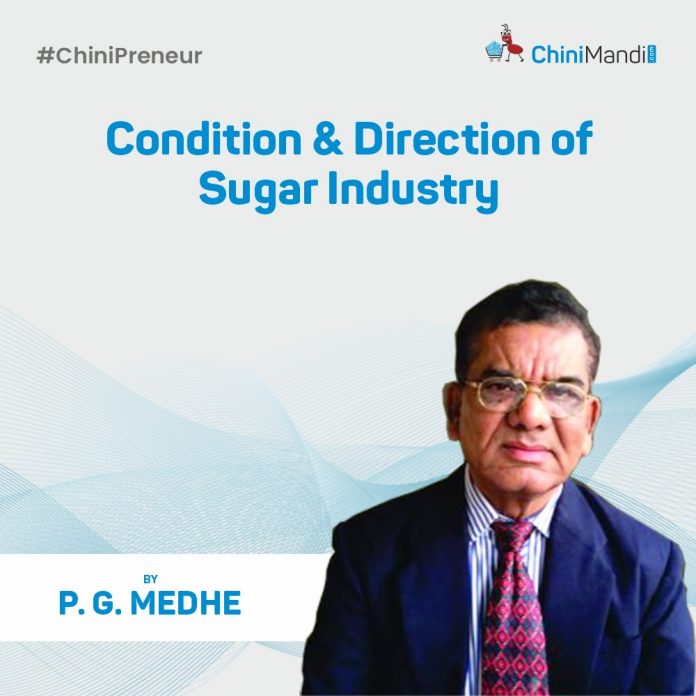“Forward-looking approach”: A necessity of the Indian sugar industry!

The Indian sugar industry indeed faces the imperative to adopt a forward-looking approach to meet evolving consumer preferences and market demands, especially considering the growing awareness of the health implications associated with excessive sugar consumption. To address this challenge, the industry must innovate and adapt in several key areas:
1)Health-Conscious Consumer Trends: With increasing concerns about sugar’s impact on health, consumers are seeking healthier alternatives or reduced-sugar options. This shift in consumer behavior necessitates the development of sugar products with lower glycemic index or alternatives with added nutritive value.
2) Innovative Product Development: The industry can explore alternatives to traditional sugar. These alternatives provide sweetness with lower calorie content and may offer additional health benefits.
3) Affordability and Accessibility: While developing healthier sugar alternatives, it’s crucial to ensure affordability and accessibility for consumers across various socioeconomic strata. This may require investment in research and development to scale up production and reduce costs.
4) Legal Obligations and FRP for Cane: The Fair and Remunerative Price (FRP) for sugarcane, mandated by the government, poses a challenge for sugar producers. While ensuring fair compensation for farmers is important, it can sometimes create financial constraints for sugar mills, affecting their ability to invest in innovation and modernization.
5) Regulatory Compliance: Compliance with regulatory standards and labeling requirements for new sugar products or sweeteners is essential. Navigating legal obligations while introducing innovative products may involve extensive testing, documentation, and regulatory approvals.
6) Supply Chain Optimization: Streamlining the sugarcane supply chain and improving efficiency in processing can help mitigate costs and enhance competitiveness. Investments in technology and infrastructure, such as modernized mills and transportation systems, can improve productivity and reduce operational inefficiencies.
7) Consumer Education and Awareness: Educating consumers about the benefits of healthier sugar alternatives and their impact on health can drive demand and acceptance in the market. Marketing campaigns emphasizing the nutritive value and affordability of these products can help shift consumer preferences.
In summary, the Indian sugar industry must embrace innovation and forward-looking strategies to meet the dual challenges of changing consumer behavior and regulatory obligations. By investing in research and development, optimizing operations, and educating consumers, the industry can adapt to evolving market demands while promoting healthier sugar options at affordable prices.
But for a forward looking approach the main obstacle comes in between is a cost effective price for the sugar produced. There is a mismatch between the cost of production of sugar and the realization from the sugar. This requires to be changed by formulating appropriate policy suitable for producers as well as consumers. This can be achieved by announcing the “Duel Price Policy for Sugar “
DUEL SUGAR PRICE POLICY : Having different pricing policies for sugar based on its end use, such as distinguishing between sugar for home consumption and industrial purposes, can indeed be a strategy to balance consumer needs and industrial demands. This could involve setting different Minimum Support Prices (MSPs) for brown sugar/Sulphur less sugar intended for home use and white crystal sugar meant for industrial applications. Such a policy may help ensure affordability for consumers while also addressing the requirements of the industrial sector.
QUOTE :
Amidst controversies relating sugar with health, sugar industry has to adopt a forward looking approach to produce sugars as per changing consumer behavior, domestic sector specific requirements and overseas market demand as well. We have to change the product profile to deliver a better sweetener having nutritive value to the consumers at affordable prices.
-NARENDRA MOHAN, FORMER DIRECTOR, NATIONAL SUGAR INSTITUTE
COST EFFECTIVE POLICY FOR SUGAR CANE PLANTATION BY ENHANCING LAND PRODUCTIVITY…Consolidated farming!
Formulating a policy for consolidated farming at the village level to enhance soil productivity in cane plantations through modern technologies and mechanized farming can involve several key components:
1) Integrated Farming Plans: Develop comprehensive farming plans that integrate modern technologies and best practices for cane plantations. This can include soil testing, crop rotation, intercropping, and integrated pest management.
2) Technology Adoption: Encourage the adoption of modern farming technologies such as precision agriculture, drip irrigation, mechanized planting and harvesting equipment, and soil health monitoring systems to optimize resource use and maximize yields.
3) Training and Extension Services: Provide training and extension services to farmers on the use of modern farming equipment and techniques. This can be done through workshops, demonstration farms, and partnerships with agricultural experts and institutions.
4) Land Consolidation: Encourage land consolidation initiatives to mitigate the effects of shrinking land holdings due to family divisions. This can involve promoting cooperative farming arrangements, land pooling schemes, or incentives for joint farming ventures.
5) Financial Support: Provide financial support in the form of subsidies, grants, or low-interest loans for farmers to invest in modern farming equipment, technologies, and infrastructure.
6) Market Linkages: Facilitate access to markets for farmers’ produce by establishing market linkages, supporting value-added processing facilities, and promoting farmer cooperatives or producer organizations.
7) Research and Development: Invest in research and development to adapt modern technologies and farming practices to local conditions, including soil types, climate variability, and pest pressures.
8) Policy Incentives : Offer policy incentives such as tax breaks, insurance schemes, or price guarantees to encourage farmers to adopt modern farming practices and participate in consolidated farming initiatives.
By implementing these policy measures, villages can enhance soil productivity in cane plantations, optimize land use, and improve the livelihoods of smallholder farmers while contributing to the sustainability of the agricultural sector.
PRECAUTIONARY MEASURES : To ensure the acceptance of the Consolidated Farming policy among farmers and preserve their ownership of land, the scheme can be designed without any disturbances to their land ownership rights. This can be achieved by implementing the following measures:
1) Voluntary Participation: Participation in the Consolidated Farming scheme should be voluntary, allowing farmers to retain full ownership of their land and opt-in based on their preferences.
2) Contractual Agreements: Farmers can enter into contractual agreements with the governing body overseeing the Consolidated Farming initiative. These agreements should clearly outline the terms and conditions, including the distribution of expenses and incomes based on their respective land holdings.
3) Transparent Governance: Establish transparent governance mechanisms to ensure that the interests of all participating farmers are safeguarded. This can include the formation of farmer committees or cooperatives to oversee decision-making processes and resource allocation.
4) Fair Distribution of Expenses and Incomes: Expenses and incomes generated from the consolidated farming activities should be distributed equitably among participating farmers based on the size of their land holdings. This ensures fairness and encourages active participation.
5) Legal Protections: Provide legal protections to farmers to safeguard their land ownership rights and ensure that their participation in the scheme does not jeopardize their property rights in any way.
6) Democratic Decision-Making: Ensure that key decisions regarding the Consolidated Farming scheme are made through democratic processes, with active participation from all stakeholders, including farmers, local authorities, and agricultural experts.
By implementing these measures, the Consolidated Farming policy can effectively enhance soil productivity and promote modern farming techniques without infringing upon farmers’ land ownership rights. This approach aligns with democratic principles and encourages active participation from all stakeholders, leading to the sustainable development of the agricultural sector.
CONCLUSION: In conclusion, the production of a better sweetener with nutritive value for consumers at an affordable price can be achieved through the modernization of plant and machinery in sugar factories. Additionally, to enhance land productivity and reduce sugar cane production costs, the implementation of consolidated farming at the village level without disrupting farmers’ land ownership rights is essential. Coupled with a sugar price policy and guaranteed Fair and Remunerative Price (FRP) for sugar cane, the formulation of detailed sugar cane production and pricing policies, including a dual sugar price policy from the government, will effectively serve this purpose. However, the crucial ingredient for the success of these initiatives lies in political will and commitment to prioritize agricultural development and the welfare of farmers. With political determination and concerted efforts, these policies can contribute significantly to the sustainability and prosperity of the sugar industry and rural communities alike.
Mr. P.G. Medhe is the former Managing Director of Shri Chhatrapati Rajaram Sahakari Sakhar Karkhana Ltd and sugar industry analyst. He can be contacted at +91 9822329898.
Source Link : https://www.chinimandi.com/forward-looking-approach-a-necessity-of-the-indian-sugar-industry/
















